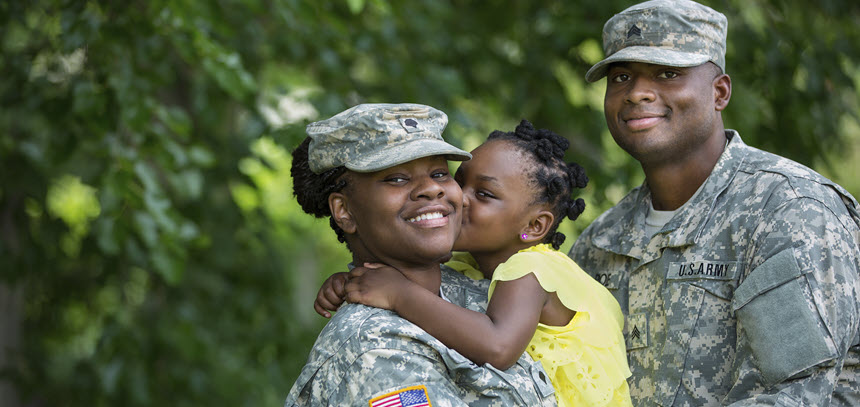For The Military Community

The FINRA Investor Education Foundation delivers free, unbiased financial education tools and training to service members, their spouses and on-base financial educators through a variety of projects and public awareness initiatives. Use the tabs above to access financial readiness resources intended to help military families manage their money with confidence.
Making the Most of Your Military Money: Save, Save, Save
The FINRA Foundation holds a Department of Defense Financial Readiness Network Statement of Support and holds a USCG Qualified Organization Designation. Learn more about the FINRA Foundation's Military Financial Readiness Project.
These resources can help you with the basics of saving, spending, and planning for a bright financial future.
Activate Your GI Bill Benefits
GI Bill benefits help you pay for college, graduate school, and training programs. Learn more from the U.S. Department of Veterans Affairs.
Free Credit Score and Analysis Tool
The FINRA Foundation makes FICO® credit scores and tools available free of charge to active duty service members and their spouses.
How to Shop for a Mortgage
Before you can buy a house, you will need to shop for—and qualify for—a home loan.
Free Tax Help for Military Families
Special tax rules, exclusions, extensions, and deployment can make tax season difficult for military members and their families.
Make the Most of Lump Sum Payments
One-time lump sum payments for injuries, loss of life, insurance, or lawsuit proceeds can replace lost future income. Take steps to ensure that they provide a long-term benefit for your family.
Military Affinity Fraud
Military ties can be used to commit financial fraud. Hear one veteran's story and learn to protect yourself from scams.
Personal Finance Basics
Learn how to set your financial goals, get a handle on your cash flow, control spending, manage debt, and get on the path to saving and investing.
Learn to Invest
Want to get smarter about investing? These quick courses build essential investment knowledge and skills. Try a course today.
Take Control of Your Finances
Here are five steps to help you manage your finances and start investing.
Tools and Calculators
Make informed financial decisions based on your own personal circumstances and financial needs.
A life in the military means a life of change—including changes in duty stations and deployments around the world. And while it includes many positive experiences, this life of moves is also very stressful.

Making the Most of Your Military Money:
Moving Guide for Military Personnel and Families
The difference between a painful move and a positive one often depends on your family’s level of readiness—especially financial readiness.
This guide from the FINRA Foundation offers steps you can take to protect your family and your finances—before, during, and after your move or whenever duty calls.
Financial Tips for Your Next PCS Move
To prepare for a life of moves, you need to know what to expect both before and after a move.
Preparing Your Finances for Deployment
Developing a deployment financial plan and saving regularly will allow you to concentrate on your upcoming duties.
Talk to Your Spouse About Money
Talking about money issues can be stressful. Talking about them while a service member is deployed to a remote location can be more so.
Participate in the Savings Deposit Program
The SDP was designed to provide members of the uniformed services in designated combat zones an opportunity to build their financial savings.
Investing in Real Estate: The Inadvertent Landlord
Managing real estate from afar can be a challenge for a family living the military lifestyle. You should approach real estate with the same care you would take before making any investment.
Getting to Know the Servicemembers Civil Relief Act (SCRA)
SCRA offers a variety of provisions to help active duty personnel meet their legal and financial obligations. But relief under the SCRA is not always automatic.
Quick Tips on Preparing for Deployment
Whether you’re saving for long-term goals (including traditional retirement from the workforce) or transitioning to civilian employment after separating or retiring from the military, planning ahead is an important step in the path to a secure financial future.
Understand Your Thrift Savings Plan
Service members have access to one of the lowest-cost ways to save for retirement. Make the most of your TSP savings opportunity.
Rolling Over Funds from TSP
If you are thinking about rolling over money from your TSP into an IRA, take some time to consider your options.
Get to Know the BRS
Explore the Uniformed Services Blended Retirement System (BRS), from eligibility to benefits to resources, using these tools from the Department of Defense.
Retirement Savings for Spouses
Saving for retirement can get complicated for military spouses on the move, but you can still make the most of tax-advantaged retirement savings plans.
Benefits Checkup
Before you leave the military, take advantage of the many benefits the service provides, and make decisions about replacing those you may lose.
Housing After the Military
If you plan to move after the military, keep these points in mind when making your housing decisions.







